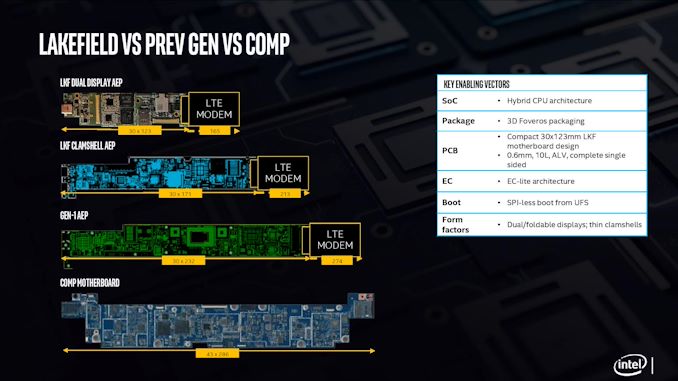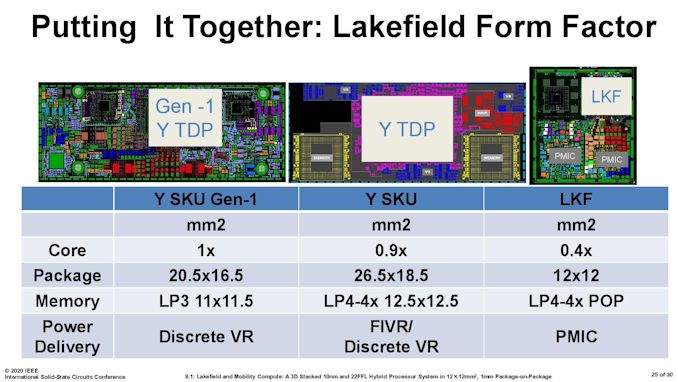The Intel Lakefield Deep Dive: Everything To Know About the First x86 Hybrid CPU
by Dr. Ian Cutress on July 2, 2020 9:00 AM ESTLakefield in Terms of Laptop Size
In a traditional AMD or Intel processor designed for laptops, we experience two to eight processing cores, along with some graphics performance, and it is up to the company to build the chip with the aim of hitting the right efficiency point (15 W, or 35/45 W) to enable the best performance for a given power window. These processors also contain a lot of extra connectivity and functionality, such as a dual channel memory controller, extra PCIe lanes to support external graphics, support for USB port connectivity or an external connectivity hub, or in the case of Intel’s latest designs, support for Thunderbolt built right into the silicon without the need for an external controller. These processors typically have physical dimensions of 150 square millimeters or more, and in a notebook, when paired with the additional power delivery and controllers needed such as Wi-Fi and modems, can tend towards the board inside the system (the motherboard) totaling 15 square inches total.

One of Qualcomm’s examples from 2018
For a Qualcomm processor designed for laptops, the silicon is a paired down to the essentials commonly associated with a smartphone. This means that modem connectivity is built into the processor, and the hardware associated with power delivery and USB are all on the scale of a smartphone. This means a motherboard designed around a Qualcomm processor will be around half the size, enabling different form factors, or more battery capacity in the same size laptop chassis.
With Intel’s new Lakefield processor design, the chip is a lot smaller than previous Intel implementations. The company designed the processor from the ground up, with as much included on the CPU as to not need additional chips on the motherboard, and to fit the dimensions similar to one of Qualcomm’s processors. Above is a slide showing how Intel believes that with an LTE modem included, a Lakefield motherboard can move down to 7.7 square inches, similar to a Qualcomm design. This leaves more room for battery inside a device.
When Intel compares it against its own previous low power CPU implementations, the company quotes a 60% decrease in overall board area compared to its first generation 4.5 W processors.
It is worth noting that for power delivery, Intel placed MIMCAPs inside the Lakefield silicon, much like a smartphone processor, and as a result it can get by on the power delivery implementation with a pair of PMICs (power management ICs). The reason why there is two is because of the two silicon dies inside – they are controlled differently for power for a number of technical reasons. If each layer within an active stacked implementation requires its own PMIC, that would presumably put an upper limit on future stacked designs – I fully expect Intel to be working on some sort of solution for this for it not to be an issue, however that wasn’t implemented in time for Lakefield.
For those that are interested, Lakefield’s PMICs are under the codenames Warren Cove and Castro Cover, and were developed in 2017-2018.












221 Comments
View All Comments
Alistair - Thursday, July 2, 2020 - link
The only point of this is if it is dirt cheap. You don't pay a premium for 1 core and 4 atom cores. DOA. I'll take a 7nm 4 core Zen 2 laptop instead thanks.Make this a $50 CPU? Then I'm interested.
lmcd - Thursday, July 2, 2020 - link
I don't think it'll be $50 but if it is, I hope to see it on single-board computers. That'd be slick.serendip - Thursday, July 2, 2020 - link
It's meant for $1000 computers, not cheap sub-$500 devices. I wouldn't pay that much money for 4 Atom cores and a big core that sits around like an unwanted appendage.lmcd - Friday, July 3, 2020 - link
It's meant for $1000 tablets and ultralights, not traditional computer form factors.Glad you won't buy any smartphone then!
yeeeeman - Friday, July 3, 2020 - link
Qualcomm is fighting in the same space with 8cx for the same huge prices and that one doesn't even run x64 apps. This market wants very light laptops with very good battery life and LKF does just that, wherever you like it or not.Spunjji - Monday, July 6, 2020 - link
We'll see what the market actually wants when this launches. I have a strong suspicion that the market doesn't want the absolutely miserable performance/$ on offer here, even for the quoted battery life benefits, but I've been wrong before.justing6 - Thursday, July 2, 2020 - link
Amazing article! I learned so much about Lakefield and 3D stacking in general. The technology and engineering is really incredible, but as a consumer product it looks extremely lacking.I'm a proud owner and heavy user of a Surface Pro X, and the 8cx/SQ1 is generally "good enough" when running ARM workloads. Going to a 15W Intel chip that can turbo to 25-40W feels noticeably snappier, but when considering the SQ1 is 7W-15W it's really impressive. The 4+4 also allows for very good multitasking performance, it takes 10GB+ of heavy web browser tabs running on an external 3440x1440p display before it really feels like it starts to slow down.
However, that's when I live inside Chromium Edge running native ARM64 code. Performance is still laughable compared to Apple Silicon, especially for translated x86 code. On Geekbench the A12z on the dev kits running translated x86 code is just as fast as the 8cx running native ARM code, while the 8cx's performance really suffers when it has to run anything more complicated than a text editor or video player written in x86. I expect Apple's successor to the A12z to mop the floor with this whole market at the same price points, even for x86 code. On top of this, Apple has unparalleled leverage over developers by controlling its entire hardware stack. I wouldn't be surprised if in 2 years, all major MacOS applications will be compiled for native ARM64 code. On the other hand, Windows on ARM64 is almost 2 years old now and has very few natively compiled apps.
I really prefer Windows, but it's going to be a hard choice for me and a lot of consumers if a Lakefield/8cx ultraportable running Windows costs the same as an Apple ultraportable on Silicon that has somewhere around double the performance for the same price, while still keeping a thin and light design with great battery life. Intel and Qualcomm will be fighting for a distant second place.
jeremyshaw - Thursday, July 2, 2020 - link
So you're saying a desktop with desktop TDP outperforms a fanless tablet with tablet TDP?I do agree Apple has a stronger push (and will have to, since they are moving their entire ecosystem over, and anyone that isn't fully onboard will simply be left behind).
Qualcomm got too greedy, Nvidia doesn't want to fight in that market anymore (remember the original Surface tablets with Nvidia Tegra chips?), and nobody else is really eyeing the laptop/consumer segment outside of Apple.
Oh, well. Some people are propping up the PINE64 as if it's worth anything.
lmcd - Thursday, July 2, 2020 - link
No one's come up with an exciting killer app beyond video decoding for smartphones or tablets so might as well "prop up" the PINE64 :)Hopefully Broadcom will get interested in SoCs again with the work they're doing with the RPi foundation. ARM is going toward powerful CPU cores anyway so it shouldn't take an Apple-sized company to come up with competitive ARM designs.
justing6 - Thursday, July 2, 2020 - link
Considering an iPad Pro (a fanless tablet) running an A12z puts up Geekbench 5 scores 30% to 60% higher that the SQ1/8cx single/multi core respectively when running native ARM code, it's safe to say its a generation or two ahead of anything Qualcomm has. I also doubt they changed much with the TDP of the chip in the Arm transition Dev kit, if anything they made it less powerful by disabling the 4 small cores and leaving it only with the 4 large cores to give them more time to work out the big.LITTLE scheduling in MacOS. A 30% hit to performance when running x86 code sounds about right, its just that the chip has so much more raw power than the 8cx that it will be able to give users a much better experience.I'm not an Apple fan by any means, but I am a fan of innovation. Apple has been pretty stagnant on that front the past decade, but with the move to ARM they have a chance to really get ahead of the market like the Apple of the 2000s.